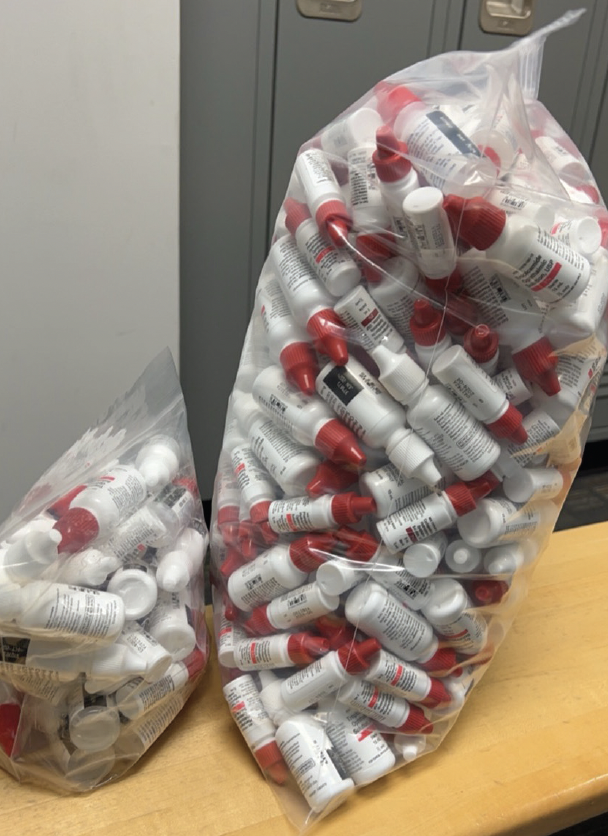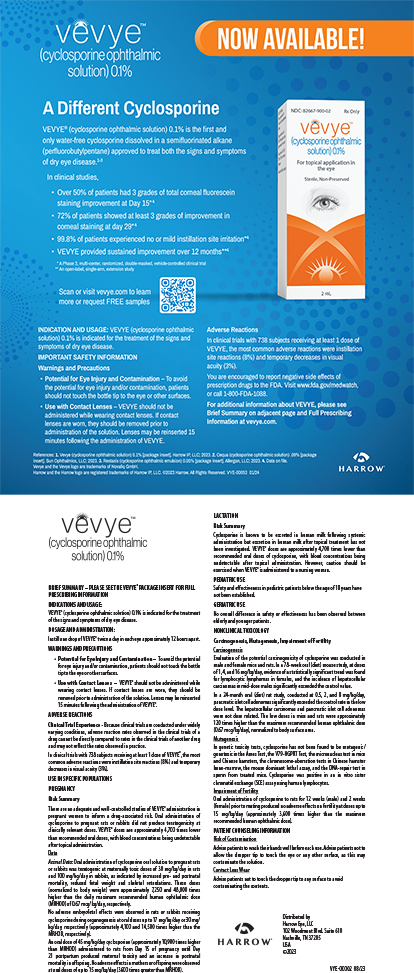

Cataract surgery is the surgical procedure with the highest volume in the United States and globally, meaning it has a significant impact on medication and material disposal (Figure 1).1-3 Studies have identified various sources of greenhouse gas emissions within the supply chain. These include the procurement of pharmaceuticals (18%) and medical equipment (33%), building energy use (36%), and travel (10%).4

Figure 1. Example of the numerous waste bags that accumulate in an OR from one cataract procedure in the United States.
Research conducted at four surgical facilities in the Northeastern United States has revealed that up to two-thirds of medications are wasted during cataract procedures.3 This waste translates to an average cost of $150 per surgical case.3 With approximately 3.8 million cataract surgeries performed annually in the United States, the potential annual cost of this waste is $560 million. Additionally, discarded medications contribute between 23,000 and 105,000 metric tons of carbon dioxide emissions, exacerbating climate change and associated health issues.
Topical medications are often discarded postoperatively in the OR without clear justification (Figure 2). This raises the question of how ophthalmologists can tackle the growing trends in waste as well as the associated monetary and environmental costs.

Figure 2. Eye drop bottles designated for multidose use discarded in a waste-sorting bin in the OR to ensure they are not used on multiple patients, despite the manufacturer’s labeling for their use until the expiration date.
LEGISLATIVE ACTIONS AND ADVOCACY EFFORTS
An ophthalmologist in Illinois known to the authors provided a partially used topical medication to a patient for use at home after cataract surgery. This action led to a citation by the ambulatory surgery center (ASC) for policy violations unknown to the surgeon. Subsequent investigations revealed that, although the Illinois Pharmacy Practice Act permits patients to take their medications home if properly labeled, the ASC pharmacy lacked adequate staff to label the medications and provide necessary patient medication counseling.
One of us (D.J.P) submitted a resolution to the Illinois State Medical Society, which was later enacted into state law (PA 102-0155) in 2021.5 This law mandates that medications be ordered more than 24 hours before surgery and properly labeled by the pharmacy upon discharge from the OR and that physician-conducted medication counseling be available as needed for continuing treatment. These initiatives were supported through advocacy discussions with peers, negotiations by the Illinois State Medical Society with the state pharmacy board and hospital association, identification of legislative champions and lobbyists, and support from other specialty and environmental groups.
The AAO subsequently developed a template for the Topical Waste Reduction Act that was modeled after the Illinois law and encouraged its adoption by other states.6 To date, Tennessee, Colorado, Delaware, and Nebraska have successfully enacted similar laws. In 2021, the AMA adopted a similar resolution titled, “Permitting the Dispensing of Stock Medications for Post-Discharge Patient Use and the Safe Use of Multidose Medications for Multiple Patients.”7
THE TOPICAL OR WASTE TASK FORCE
The Topical OR Waste Task Force was established in 2021. It includes members from the ASCRS, AAO, American Glaucoma Society, and Outpatient Ophthalmic Surgical Society and has support from the AAO and ASCRS Government Affairs offices as well as the AMA Ophthalmology Section Council.
The Task Force compiled evidence-based data from statewide, national, and international surveys.8-10 On average, the data showed that only 30% of patients were taking their partially used OR eye drops home for continued care even though more than 98% expressed a desire for this option. Moreover, 90% of respondents considered OR waste excessive and raised concerns about climate change, with 95% favoring the use of multidose eye drops for multiple patients.
There were reports of increased inflammation and infection among some of the patients who did not receive their medications postoperatively, which emphasizes the issue’s importance to quality of care.8 In 2022, the Task Force published a position paper (1) advocating for the use of multidose eye drops for multiple patients until the manufacturer’s expiration date is reached, in accordance with Centers for Disease Control and Prevention infection control guidelines, and (2) supporting facilities’ provision of partially used topical OR medications for postoperative use when appropriate.11 Advocacy included policy and legislative changes initiated at the state and national ophthalmology and medical society levels. The Task Force later that year became EyeSustain (ES), an international clearinghouse for evidence-based data on sustainability in ophthalmology, that collaborates with the AAO’s newly established Committee on Sustainability.
IMPACT OF REGULATORY PROGRAMS ON DRUG SHORTAGES
Discarding multidose bottles of topical medication after a single use has been identified as a risk factor for drug shortages, a concern so significant that the US Department of Homeland Security classified it as a national security risk in 2023 (Figure 3).12 The gravity of the issue was demonstrated by the 2023 bankruptcy of Akorn Pharmaceutical, which had previously supplied 90% of the topical phenylephrine in the market, resulting in acute and chronic shortages interfering with patient dilated examinations and surgeries nationally.13

Figure 3. Anesthetic and dilation eye drops discarded after single use on approximately 75 preoperative cataract surgery patients.
Variations in the policies on the multiuse of eye drops among institutions and ASCs reflect concerns over sterility and patient safety. Challenges include programming electronic medical record systems to print proper eye drop labels, revising state laws that prohibit the multidosing of eye drops, and legislatively addressing government-mandated policies that encourage drug waste, such as the Section 340B Program.
The Section 340B Program, a federal pharmaceutical outpatient program overseen by the US Department of Health and Human Services and the Health Resources and Services Administration, offers medication discounts to eligible hospitals based on patient population. One factor contributing to excessive waste and drug shortages under this program is the frequent discarding of eye drops after a single use. Facilities often act out of concern that discrepancies—in the number of multidose eye drops administered versus the initial fill volume—found during audits might render them ineligible for Section 340B benefits.
The CMS Surveyor Infection Control Working Group audits ASCs and has cited facilities for using multidose eye drop bottles beyond 28 days. Originally, the audit checklist used by this group mistakenly applied the 28-day expiration guideline for single-use injectables to eye drops. In 2022, a national checklist revision was facilitated by the AAO Government Affairs office and ES members.14 This revision permits the use of eye drops up to the manufacturer’s expiration date, which aligns with actual product specifications.
STRATEGIES TO ADDRESS DRUG SHORTAGES
Based on congressional testimony from members of the AAO and ES as well as a Council on Science & Public Health Report adopted by the AMA in November 2023, recommended strategies to mitigate drug shortages include the following:
- Modify policies that prohibit multidose eye drops and generate excessive waste under the Section 340B Program;
- Encourage the US FDA to outsource the production of generic drugs with high shortage risks to compounding pharmacies;
- Increase government subsidies for manufacturers producing lower-margin generics with extended production times to cover retooling costs; and
- Enhance the domestic sourcing of raw materials.
The Senate Finance Committee recently introduced bipartisan legislation aimed at preventing and reducing generic drug shortages as a result of this testimony.15
ADDRESSING DRUG WASTE AND SUSTAINABILITY IN HEALTH CARE
ES board members are actively conducting legislative mapping of multidosing policies across all 50 states as a step toward advocating for necessary policy modifications.
The outcomes of further safety studies on eye drop multidosing appear promising. For instance, a study conducted by the Aravind Eye Care System found no contamination of eye drop bottle tips or solutions after 1 day of use on multiple patients.16 Another study projected significant cost savings, with an estimated 5-year reduction in expenses of $280,000 after the implementation of preoperative multidosing protocols.17
By sharing sustainability initiatives with other medical specialties, engaging with organizations such as Practice Greenhealth and My Green Doctor, and supporting compliance with the Sustainable Healthcare Joint Commission Certification program, ES aims to accelerate the adoption of sustainable practices across hospitals and clinics.
Drug waste and sustainability are pressing concerns that affect physicians and society. ES has introduced a voluntary surgery pledge aimed at reducing cost and waste,18 and the US Department of Health and Human Services has committed to the Health Sector Climate Pledge, which set a goal of net-zero emissions by 2050.19 As patient advocates, ophthalmologists can effect transformative change within their institutions and ORs. By doing so, they enhance patient care while fostering a health care ecosystem that is rooted in efficiency, responsibility, and innovation.
1. Sherry B, Lee S, De Los Angeles Ramos Cadena M, et al. How ophthalmologists can decarbonize eye care: a review of existing sustainability strategies and steps ophthalmologists can take. Ophthalmology. 2023;130(7):702-714.
2. Eckelman MJ, Sherman JD. Estimated global disease burden from US health care sector greenhouse gas emissions. Am J Public Health. 2018;108(S2):S120-S122.
3. Tauber J, Chinwuba I, Kleyn D, Rothschild M, Kahn J, Thiel CL. Quantification of the cost and potential environmental effects of unused pharmaceutical products in cataract surgery. JAMA Ophthalmol. 2019;137(10):1156-1163.
4. Morris DS, Wright T, Somner JE, Connor A. The carbon footprint of cataract surgery. Eye (Lond). 2013;27(4):495-501.
5. Public Act 102-0155, SB0579 Enrolled, LRB102 04222 CPF 14239 b, Illinois General Assembly (2021). Accessed April 30, 2024. https://www.ilga.gov/legislation/publicacts/fulltext.asp?Name=102-0155
6. Mukamal R. Making ophthalmology more sustainable. EyeNet Magazine. November 2023. Accessed April 30, 2024. https://www.aao.org/eyenet/article/making-ophthalmology-more-sustainable
7. American Medical Association. Permitting the dispensing of stock medications for post-discharge patient use and the safe use of multi-dose medications for multiple patients. D-120.929. Accessed April 29, 2024. https://policysearch.ama-assn.org/policyfinder/search/permitting%20the%20dispensing%20of%20stock%20medications/relevant/1/
8. Palmer DJ, Volpe NJ, Hackett NJ. Improving quality of care and reducing topical medication operating room waste. J Cataract Refract Surg. 2020;46(8):1200-1201.
9. Chang DF, Thiel CL; Ophthalmic Instrument Cleaning and Sterilization Task Force. Survey of cataract surgeons’ and nurses’ attitudes toward operating room waste. J Cataract Refract Surg. 2020;46(7):933-940.
10. Chang DF, Elferink S, Nuijts RMMA. Survey of ESCRS members’ attitudes toward operating room waste. J Cataract Refract Surg. 2023;49(4):341-347.
11. Palmer DJ, Robin AL, McCabe CM, Chang DF; Ophthalmic Instrument Cleaning and Sterilization Task Force. Reducing topical drug waste in ophthalmic surgery: multisociety position paper. J Cataract Refract Surg. 2022;48(9):1073-1077.
12. Jewett C. Rising rate of drug shortages is framed as a national security threat. The New York Times. March 22, 2023. Accessed April 30, 2024. https://www.nytimes.com/2023/03/22/health/drug-shortages.html
13. Williams RD, Chambers WA, Ganio M, Glasser DB, Repka MX, Williams GA. The Akorn bankruptcy. EyeNet Magazine. June 2023. Accessed April 30, 2024. https://www.aao.org/eyenet/article/the-akron-bankruptcy
14. Department of Health & Human Services Centers for Medicare & Medicaid Services. Updated guidance for ambulatory surgical centers – appendix l of the state operations manual (SOM). June 3, 2022. QSO-22-16-ASC. Accessed May 10, 2024. https://www.cms.gov/files/document/qso-22-16-asc.pdf
15. Choi J. Senate Finance Committee introduces legislation aimed at fixing drug shortages. The Hill. May 3, 2024. Accessed May 6, 2024. https://www.TheHill.com/policy/healthcare/4639712-Senate-Finance-Committee-fix-drug-shortages
16. Wu AM, Kumar P, Stein JD, Venkatesh R, Zhou Y, Robin AL. A videographic evaluation of eyedrop administration by ophthalmic technicians. Ophthalmology. 2021;128(5):796-798.
17. Berkowitz ST, Finn A, Sternberg P Jr, Patel S. Potential cost savings associated with a multiuse preoperative and preinjection eyedrop protocol. Ophthalmology. 2022;129(11):1305-1312.
18. EyeSustain. Drug waste. Accessed April 29, 2024. https://eyesustain.org/topics/drug-waste
19. About the office of climate change and health equity (OCCHE): health sector commitments to emissions reduction and resilience. US Department of Health and Human Services. Accessed April 29, 2024. https://www.hhs.gov/climate-change-health-equity-environmental-justice/climate-change-health-equity/actions/health-sector-pledge/index.html#:~:text=Specifically%2C%20pledge%20signers%20commit%20to,on%20this%20goal%20every%20year




